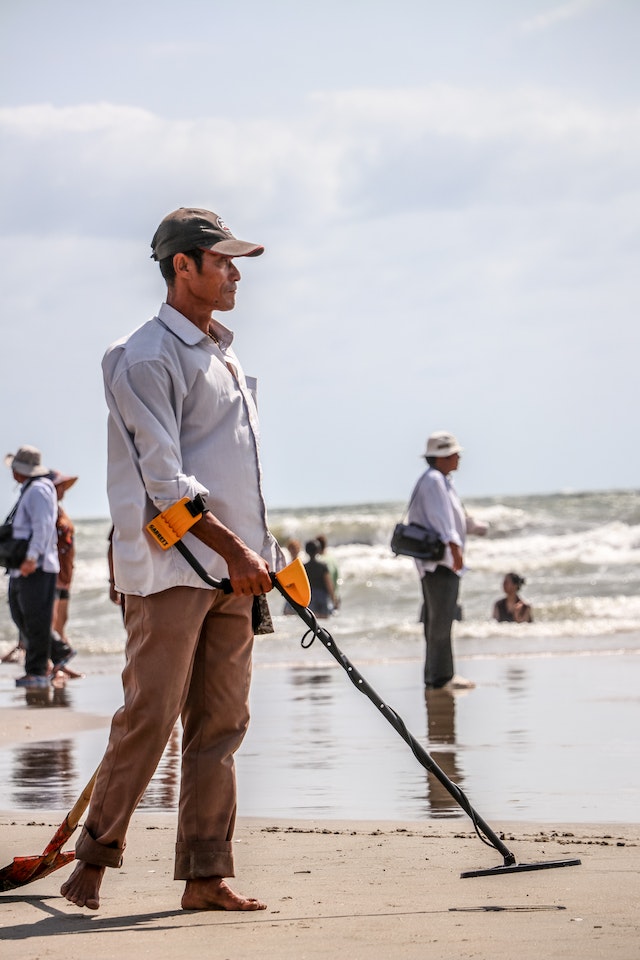
How do metal detectors work? Metal detectors work by transmitting an electromagnetic field that energizes any metal near it.
There are three different types of metal detector and they all work in slightly different ways. These different types are very low frequency (VLF) detectors, pulse induction (PI) detectors, and beat-frequency oscillator (BFO) detectors.
VLF detectors are the most common. They have a transmitter and a receiver that are both made of coiled wire. An electric current is sent through the transmitter coil and it creates a magnetic field that extends away from the detector and down into the ground. When the magnetic field encounters a metal object in the ground, the metal object is magnetized, producing a magnetic field of its own. The magnetic field from the detector pushes down, but the magnetic fields produced by any metallic objects in the ground have an opposite polarity and push upwards. The receiver coil is sensitive to magnetic fields and when it encounters one, it receives an electric charge, which is analyzed by the metal detector’s control box. The metal detector can tell how deep the object is by analyzing the strength of the magnetic field it has picked up.
PI detectors work by sending very rapid pulses of electricity through a transmitter coil. The pulse of current creates an electric field which is sent into the ground below the detector. When the current ends, the magnetic field collapses and sends a short burst of current back through the coil. This is called a “reflected pulse”. The reflected pulse only lasts about 30 microseconds. If the magnetic field encounters a metal object in the ground, that object is magnetized and its magnetic field mingles with the magnetic field from the detector, making the reflected pulse longer than usual. The detector can spot the delay and sends a warning to the user. PI detectors can detect much deeper than VLF detectors, but they are less common.
BFO detectors have two wire coils and thousand of pulses of current are sent through each coil a second. The frequency of the pulses is slightly offset, which creates radio waves. If there is a metal object in the soil, the magnetic field from the detector magnetizes it, and that magnetic field interferes with the radio waves from the detector. The detector picks up on this a warns the user. BFO detectors are simple and very cheap to make, so they are quite common. They are not as good as other detectors.
Detectors can tell different types of metal apart because of their conductivity. All metals have different levels of resistance. For example, gold has a low resistance and steel has a high resistance. If a metal has a low resistance, it conducts electricity easily, yet takes a while to produce a magnetic field. Metals with a higher resistance don’t conduct electricity easily, but produce a magnetic field very quickly. VLF metal detectors can tell the length of time that it took for the metal to produce its magnetic field and they can use that to guess at what kind of metal it is. Someone searching for treasure could set the detector not to respond to steel, a modern metal, or iron, present in things like nails. Minerals, such as salts and irons, in different types of soil can also produce a magnetic field, so a good detector can separate these background signals out.
Metal detectors were first invented to be used by miners because they would allow people to find gold and iron under the ground. A later adaption allowed them to be used when removing bullets during surgery. During World War 2, they were used for finding mines. American historian Don Rickey was the first person to use a metal detector for archaeology in 1958. He tried to find the firing lines at the Little Big Horn.
There are a lot of hobbyists using metal detectors and they have made some very impressive finds, but a lot of archaeologists don’t appreciate it because the detectorist can disturb archaeological areas. They also remove objects without making note of its location. Often, the context of where something is can be just as important in understanding what the object is as simply the object itself. However, one might say that without the metal detectorists, these areas would not be discovered in the first place.
So, metal detectors generally work by stimulating an electric field in metal objects that are in the ground and then detecting that field. And this is what I learned today.
Sources
https://en.wikipedia.org/wiki/Metal_detector
https://www.minelab.com/knowledge-base/getting-started/how-metal-detectors-work
https://www.explainthatstuff.com/metaldetectors.html
https://electronics.howstuffworks.com/gadgets/other-gadgets/metal-detector.htm
https://www.thoughtco.com/table-of-electrical-resistivity-conductivity-608499
